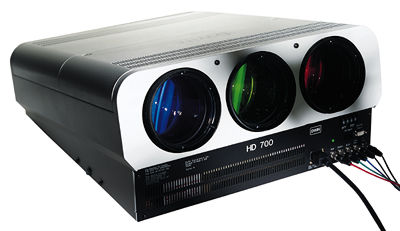Dwin HD-700 video projector

But everybody wants a great picture. And while there are no cheap CRT projectors, there are a few that many of us can seriously dream about owning. Dwin Electronics has been in the middle of the affordable CRT action since its inception, and, with the HD-700, makes it clear that they plan to stay there.
Overview
Dwin builds their projectors from the ground up, rather than modifying pre-existing chassis from a larger manufacturer. The HD-700 is an evolutionary step up from Dwin's first projector, the HDP-500, which it closely resembles in a number of important ways. It's the smallest, lightest data-grade CRT projector we know of, and one of the few designed specifically for home theater rather than data display (though it will perform that function also).
While at first glance the HD-700 physically resembles the HDP-500, the case (available in black or white) is subtly different. Handles are provided (accessible by removing the front chassis cover) to help maneuver the projector into a ceiling-mount bracket, if required. While these handles don't look too impressive, they do the job. All the electrical connections are still in front. There you'll also find the three lenses, an RS-232 port for an outboard controller, the AC connection, a multi-function power LED indicator, screen trigger contacts, and the IR sensor for the remote.
Most of the changes in the design from the HDP-500 are internal. There are new (Toshiba) "large neck" cathode-ray tubes, said to provide additional brightness and sharpness. That enhanced sharpness counterbalances Dwin's move from electromagnetic focus in the HDP-500 to the less complex (and theoretically inferior) electrostatic focus of the HD-700. The lenses are said to be fully color-corrected, which should not be confused with color filtering. Color correction preserves the color produced by the CRT as it passes through the lens; color filtering actually corrects for the inevitable errors in the tubes' phosphors. The HD-700 is not color-filtered. Dwin is not alone here; very few projectors go beyond color-corrected lenses. While color filtering can significantly improve color accuracy, it sacrifices light output and increases cost.
Unlike the HDP-500, the HD-700 will not accept standard-definition material at a 15.75kHz horizontal scanning rate. It requires an input having a scanning frequency of 30kHz or higher, which means that it requires hi-def images, or a standard-definition source that has, at a minimum, been line-doubled.
There are also some minor changes from the older projector in the way the HD-700's setup operations are configured, but nothing that should concern a potential buyer. The most radical functional change is probably the addition of a fan in the power supply. The most talked-about feature of the old HDP-500 was the absence of any fan whatsoever, something that strongly appealed to audiophiles. But even with its fan, the HD-700 upholds the HDP-500's reputation for being as silent as a church on Wednesday. If you listen closely in a very quiet room, you can just make it out; during a movie with anything at all on the soundtrack, you'll hear more noise from your DVD player than you'll hear from the Dwin.
Setup
I evaluated the HD-700 mostly in conjunction with Dwin's own line multiplier, the TranScanner, set to 645 lines. The TranScanner also took care of the aspect-ratio chores, though it was still necessary to set up the projector for the different scanning frequency the TranScanner demands for each aspect ratio. Focus is strictly mechanical, as is to be expected of a projector with electrostatic focus. There are internal adjustments for beam-spot size, but those are too close to high-voltage circuitry for anyone but an experienced installer to deal with. Indeed, our standard advice on setting up video projectors still stands: Find a dealer or independent installer with extensive experience on your chosen projector and rely on his or her expertise. But the Dwin is not a difficult projector to get up and running properly, and the installation manual clearly describes the steps required for geometric alignment. Gray-scale adjustments should be made with the appropriate measuring tools—another job for a pro.
Convergence, however, is a function that most users will, and should, become familiar with. The Dwin offers both center and highly flexible multi-point convergence. I did occasionally wish for a few more control points, and the Dwin cannot be converged using external test patterns, only its own internal ones. These limitations aside, the control offered by the HD-700 was more than sufficient to produce a well-converged image. It also tended to be much less prone to drifting over time than did our sample of the HDP-500. While a tendency to drift is more often than not due to a less-than-optimum mechanical setup, it's also possible that the new projector's internal fan, by keeping circuitry cool, results in a more stable power supply, which will also reduce drift.
- Log in or register to post comments




































































